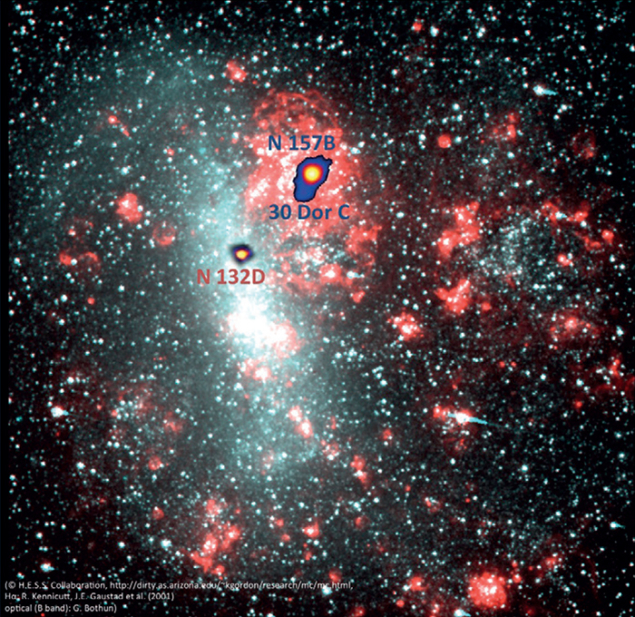
Image credit: H.E.S.S. Collaboration/Hα: R Kennicutt, J E Gaustad et al. (2001)/optical (B-band): G Bothun.
High Energy Stereoscopic System (HESS) has discovered three extremely luminous gamma-ray sources in the Large Magellanic Cloud (LMC) – a dwarf galaxy orbiting the Milky Way about 170,000 light-years away. The three objects are all exceptional. They comprise the most powerful supernova remnant and pulsar-wind nebula, as well as a superbubble – a new class of source in very high-energy (VHE) gamma rays.
The HESS array of telescopes, located in Namibia, observes flashes of Cherenkov light emitted by particle showers triggered by incident gamma rays in the upper atmosphere (CERN Courier January/February 2005 p30). This technique is sensitive to gamma rays at energies of tera-electron-volts – photons typically a thousand times more energetic than those observed by the Fermi Gamma-ray Space Telescope in the giga-electron-volt range (CERN Courier November 2008 p13). These high-energy photons are emitted by extremely energetic particles interacting with matter or radiation. They are therefore the best tracers of cosmic accelerators such as supernova remnants and pulsar wind nebulas – two different types of remains from the evolution of massive stars.
Resolving individual sources in a galaxy outside of the Milky Way is a new breakthrough for Cherenkov-telescope astronomy. HESS performed a deep observation of the largest star-forming region within the LMC, known as the Tarantula Nebula ( Picture of the month, CERN Courier June 2012 p12). The 210 hours of observation yielded the discovery of the three extremely energetic objects.
One of the new sources is the superbubble 30 Dor C. It is the first time that a superbubble has been detected in the VHE regime, and demonstrates that the objects are a source of highly energetic particles. With a diameter of 270 light-years, 30 Dor C is the largest-known X-ray-emitting shell, and appears to have been blown by several supernovas and strong stellar winds from massive stars. The detection by HESS is important because it shows that superbubbles are viable sources of galactic cosmic rays, complementary to individual supernova remnants (CERN Courier April 2013 p12).
Another source detected by HESS is the pulsar-wind nebula N 157B. This kind of nebula is formed by the wind of ultra-relativistic particles blown by a pulsar – a highly magnetized, rapidly spinning neutron star. The most famous is the Crab Nebula, one of the brightest sources in the gamma-ray sky (CERN Courier November 2008 p11). N 157B is similar, but outshines the Crab Nebula by an order of magnitude in VHE gamma rays, owing to a lower magnetic field and a stronger radiation field from neighbouring star-forming regions.
The third object is the supernova remnant N 132D, which is already known as a bright object in the radio and infrared wavebands. Although it is between 2500 and 6000 years old, it still outshines the strongest supernova remnants in the Galaxy in the VHE regime. Surprisingly, the remnant of the bright supernova SN 1987A – which exploded in the LMC 28 years ago – was not detected by HESS, in contrast to theoretical predictions. The current study published in Science shows the LMC to be a prime target for even deeper observations with the new HESS II 28-m telescope and the future Cherenkov Telescope Array (CERN Courier July/August 2012 p28).







